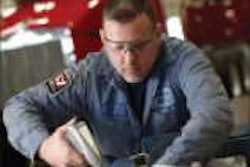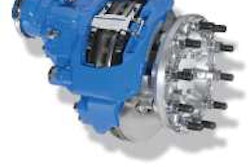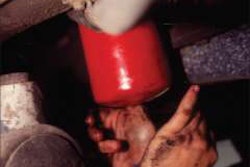The following are safety recalls recently issued by the National Highway Traffic Safety Administration:
The quick release valve cover on certain model year 2012-2013 Freightliner 108SD, Business Class M2, Cascadia and Coronado vehicles, equipped with a Haldex quick release valve, and manufactured from Feb. 3, 2012, through March 2, 2012, may not be correctly manufactured, allowing the cover to become separated from the valve body. If the cover separates from the valve body, the front brakes may not function. If this condition occurs, increased vehicle stopping distance may result, increasing the risk of a crash.
The alternator cable on certain Navistar model year 2010 through 2013 PayStar, WorkStar, TranStar and ProStar, and model year 2012 and 2013 LoneStar commercial trucks manufactured from June 1, 2009, through Apr. 4, 2012, equipped with a MaxxForce 11 or 13 engine (feature code 12UXJ or 12UXH) and with Bosch alternator feature codes 08GGN, 08GGR, 08GHG, or 08GHH may rub on the high-pressure power steering hose. This can result in chafing the insulation and causing an electrical short. An electrical short may cause a vehicle fire possibly resulting in property damage, personal injury or death. Navistar will install a standoff bracket and improve harness routing to better route the alternator wires away from the power steering hose.
The bearing system on some Featherlite model year 2006-2012 trailers equipped with a Meritor axle has exhibited low durability life in certain vehicle applications. Prolonged use of the system in these applications can result in the degradation of the bearing grease, thereby potentially resulting in a bearing failure and subsequent wheel end fire.
Certain model year 2013 Kenworth T680, and Peterbilt 579 vehicles fail to comply with the requirements of Federal Motor Vehicle Safety Standard (FMVSS) No. 121, “Air Brake Systems.” These vehicles exceed the brake timing test requirements of FMVSS 121 for trailer circuits when 15 ft. coiled trailer lines are used. The longer brake apply time may result in extended stopping distances, increasing the risk of a crash.
The brake valve plunger on certain Bendix Commercial Vehicle Systems, LLC brake valves, treadle assemblies, and/or plunger kits sold as aftermarket replacement equipment and sold and installed as original equipment to various vehicle manufacturers may fracture during brake application, resulting in reduced brake pedal angle and travel. This condition may limit the driver’s ability to deliver full pressure from the foot brake valve. There also is a potential that the brake plunger could become lodged and not allow release of the service brakes. This condition could reduce braking ability and/or lead to loss of vehicle control, increasing the risk of a crash.
The control arms on certain Dorman Products, Inc. service replacement equipment control arms, part numbers 520-121, 520-122, 2410121 and 2410122 shipped from November 2010 through January 2012, may have an inadequate heat treatment of the ball stud. This could result in premature fracture. Fracture of the ball stud on the control arm can result in impaired steering and handling, possibly resulting in a vehicle crash.
On certain Thermo King Corporation aftermarket Tripac electric auxiliary idle reduction and temperature management systems, the Tripac-e unit attaches to the tractor frame-rail several feet below or behind the tractor cab, and is operated by a driver-controlled module. These units can short circuit. A short circuit can result in overheating possibly resulting in a fire.
Certain model year 2013 Kenworth T680 vehicles equipped with a 76 in. sleeper and grey or tan color-matched bunk restraints fail to comply with the requirements of Federal Motor Vehicle Safety Standard (FMVSS) No. 302, “Flammability of interior materials.” Flammable material, in the presence of an ignition source, could result in a fire.
Modifications made to certain UD Trucks North America UD 3300 trucks, model year 2008-2010 equipped with a dual steering system may have resulted in loss of isolation between the primary and secondary air brake systems. Thus, these vehicles fail to comply with the requirements of Federal Motor Vehicle Safety Standard No. 121, “Air Brake Systems.” Modifications to the vehicles may have resulted in loss of isolation between the primary and secondary air brake systems. If the vehicle experiences an air leak in either the primary or the secondary system, the vehicle may experience a total loss of brakes, increasing the risk of a vehicle crash.
The front knuckles on certain model year 2013 Freightliner, Western Star, and Freightliner Custom Chassis trucks manufactured from Apr. 18, 2012, through May 11, 2012, and equipped with Detroit Axle-brand front axle knuckles may have a machining error in the wheel bearing area. This may lead to premature spindle failure. If the spindle fails, the wheel may separate from the knuckle, resulting in loss of vehicle control, increasing the risk of a crash.
The windshield and backlight glass on certain model year 2013 International DuraStar trucks, manufactured from Feb. 12, 2012, through Mar. 19, 2012, equipped with cab codes 16030 or 16AAK, were installed without primer seal application. Over time, this may cause separation from the cab. Without the proper bond, the windshield and/or backlight glass could separate from the cab, resulting in increased risk of personal injury or death.
Make Sure to Check Batteries
Batteries are vulnerable to vibration, chemicals, extreme temperatures and even acid vapors. While batteries do go bad, and corrosion appears, what sometimes seems to be a battery failure may not always be the case.
It is estimated that half of the batteries that have been discarded still have life in them, which means the problem is not always necessarily the battery, Phillips Industries says.
How do you determine if the battery is really the source of power failure? First, inspect the battery, its terminals and cables. Vibration is the biggest cause of battery and cable failure. Connections often become loose over time. Tightening these connections during a routine inspection can help prevent loss of power from the battery to the vehicle.
When performing routine maintenance, or inspecting the battery during power failure, look for a white powdery residue. If a battery appears to need cleaning more often than usual, or has obvious damage or cracks, it may be time to replace the battery.
Battery corrosion also leads to poor terminal connection. If you find corrosion, inspect the wiring itself for battery acid contamination. Bending the cable near the terminal will give you some idea. If the cable is stiff, there probably is corrosion and you will need to replace the cables. Be sure to use heavy-duty clamps, cables and lugs. Automotive grade parts cannot handle the load of a commercial vehicle.
Visually inspect all cables and connections to the alternator and starter. Since cables have the tendency to corrode from the inside out, it may be difficult to see how much corrosion is present. Consider installing a clear-view or see-through battery cable.
Overcharging and undercharging are both extremely bad for the electrical system and can lead to premature battery failure, Phillips says. Major battery manufacturers recommend an alternator output of 14.30 – 14.60v at 70⁰F to achieve maximum battery life.
Power failure can come from more than one source. Exhausting all sources before automatically assuming it is the battery. Diagnosing the real problem will not only save you time and money, it will save you the headache that will come with continued power failure issues that will return even with a new battery.










